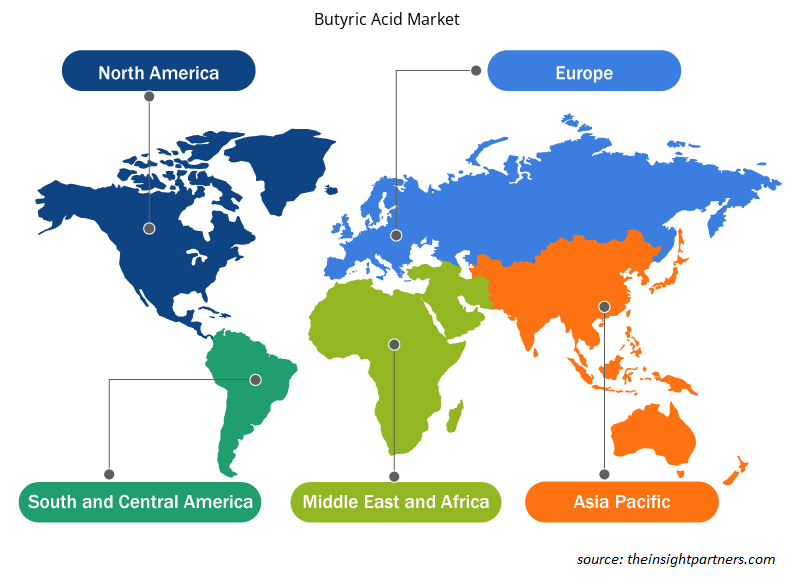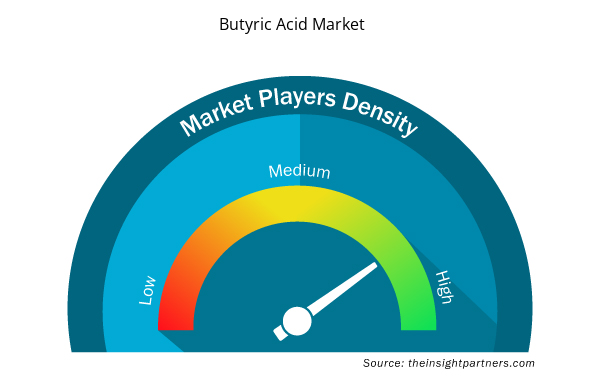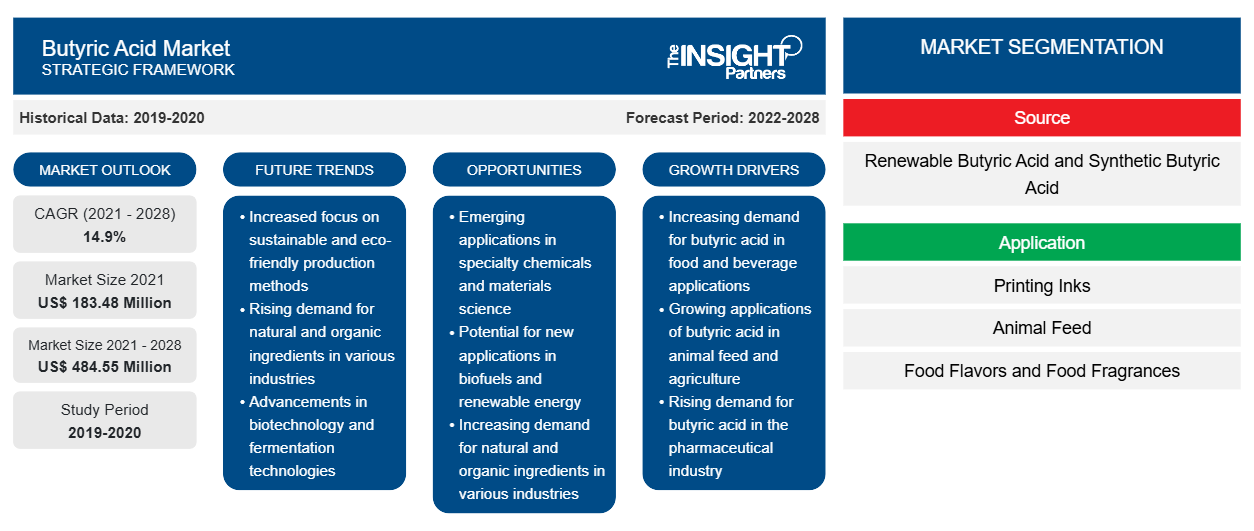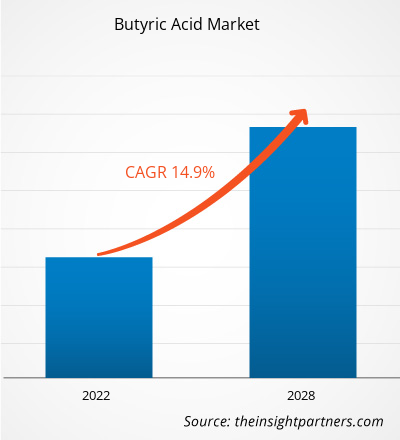Le marché de l'acide butyrique était évalué à 183,48 millions USD en 2021 et devrait atteindre 484,55 millions USD d'ici 2028 ; il devrait croître à un TCAC de 14,9 % de 2021 à 2028.
L'acide butyrique est un liquide incolore à l'odeur pénétrante et désagréable. L'acide a diverses applications importantes dans les industries chimiques, alimentaires et pharmaceutiques. L'acide butyrique a de nombreuses applications dans l'industrie pharmaceutique.
En 2020, la région Asie-Pacifique détenait la plus grande part de revenus du marché mondial. Le nombre croissant d'élevages en Asie-Pacifique augmente la consommation d'aliments pour animaux et fait proliférer par la suite le marché de l'acide butyrique . La croissance des élevages dans la région Asie-Pacifique peut être attribuée à la demande accrue de produits carnés de qualité en raison de l'amélioration du revenu par habitant et de la prise de conscience croissante des consommateurs de la région Asie-Pacifique en matière de santé.
Personnalisez ce rapport en fonction de vos besoins
Vous bénéficierez d'une personnalisation gratuite de n'importe quel rapport, y compris de certaines parties de ce rapport, d'une analyse au niveau des pays, d'un pack de données Excel, ainsi que de superbes offres et réductions pour les start-ups et les universités.
- Obtenez les principales tendances clés du marché de ce rapport.Cet échantillon GRATUIT comprendra une analyse de données, allant des tendances du marché aux estimations et prévisions.
Impact de la pandémie de COVID-19 sur le marché de l'acide butyrique
La pandémie de COVID-19 a eu un impact négatif sur les économies et les industries de divers pays en raison des confinements, des interdictions de voyager et des fermetures d'entreprises. En 2020, diverses industries ont dû ralentir leurs opérations en raison des perturbations des chaînes de valeur causées par la fermeture des frontières nationales et internationales, ce qui a limité la demande d'acide butyrique. La pandémie de COVID-19 a provoqué une volatilité des prix des matières premières nécessaires à la production d'acide butyrique. La consommation mondiale d'acide butyrique a diminué en raison de la faible demande de divers secteurs en aval, tels que les arômes alimentaires, les parfums alimentaires et les intermédiaires chimiques. La disponibilité limitée des matières premières et la réduction de la demande des secteurs en aval en raison de la pandémie de COVID-19 ont eu un impact négatif sur la croissance du marché de l'acide butyrique.
Informations sur le marché
Augmentation de la demande du secteur de l'alimentation animale
L'acide butyrique est connu pour ses effets bénéfiques sur la santé et le développement intestinaux. Depuis des décennies, il est utilisé dans l' industrie de l'alimentation animale pour assurer une meilleure santé intestinale et les performances animales. En outre, l'acide butyrique est devenu une alternative antibiotique de premier choix pour les producteurs de poulets de chair, de poules pondeuses, de dindes et de porcs, l'industrie de l'alimentation animale ayant adopté une stratégie visant à réduire l'utilisation d'antibiotiques.
Ces dernières années, l'industrie de l'élevage dans divers pays s'est rapidement développée avec l'évolution des préférences alimentaires des consommateurs vers les protéines animales. La croissance démographique, l'augmentation des revenus, l'élévation du niveau de vie et l'urbanisation ont été les principaux facteurs qui ont propulsé la demande de viande dans le monde entier. La demande croissante de produits à base de viande met en évidence le besoin d'aliments pour animaux et d'additifs alimentaires. La demande croissante de produits d'alimentation animale dans différentes régions stimule la demande d'acide butyrique, renforçant ainsi la croissance du marché de l'acide butyrique.
L'acide butyrique est l'un des acides gras à chaîne courte les plus bénéfiques qui joue un rôle clé dans l'amélioration de la santé digestive, la gestion du poids et la prévention du cancer. La forte croissance de l'industrie pharmaceutique dans différents pays du monde entraîne une utilisation croissante de l'acide butyrique pour diverses applications. En outre, l'utilisation de l'acide butyrique comme précurseur pour la production de biocarburants suscite un intérêt croissant. Cela devrait offrir des opportunités lucratives pour la croissance du marché de l'acide butyrique au cours de la période de prévision.
Informations sur les sources
Selon la source, le marché mondial de l'acide butyrique a été segmenté en acide butyrique renouvelable et acide butyrique synthétique. Le segment de l'acide butyrique synthétique détenait une part plus importante du marché mondial en 2020. Le segment de l'acide butyrique synthétique représente une part importante en raison de sa large application pour la production d'encres d'impression, de désinfectants, d'arômes, de médicaments, de parfums, de pâques et d'additifs alimentaires, entre autres.
Français Certains des acteurs opérant sur le marché mondial de l'acide butyrique comprennent Eastman Chemical Company ; OQ Chemicals GmbH ; Tokyo Chemical Industry Co., Ltd. ; Perstorp Holding AB ; Alfa Aesar ; MERCK KGaA ; Vigon International, LLC. ; Hefei TNJ Chemical Industry Co., Ltd. ; KUNSHAN ODOWELL CO., LTD ; et Yufeng International Co., Ltd. Les acteurs opérant sur le marché de l'acide butyrique se concentrent sur la fourniture de produits de haute qualité pour répondre à la demande des clients. Ces acteurs du marché sont fortement concentrés sur le développement d'offres de services de haute qualité et innovantes pour répondre aux exigences des clients.
Aperçu régional du marché de l'acide butyrique
Les tendances régionales et les facteurs influençant le marché de l’acide butyrique tout au long de la période de prévision ont été expliqués en détail par les analystes d’Insight Partners. Cette section traite également des segments et de la géographie du marché de l’acide butyrique en Amérique du Nord, en Europe, en Asie-Pacifique, au Moyen-Orient et en Afrique, ainsi qu’en Amérique du Sud et en Amérique centrale.

- Obtenez les données régionales spécifiques au marché de l'acide butyrique
Portée du rapport sur le marché de l'acide butyrique
| Attribut de rapport | Détails |
|---|---|
| Taille du marché en 2021 | 183,48 millions de dollars américains |
| Taille du marché d'ici 2028 | 484,55 millions de dollars américains |
| Taux de croissance annuel moyen mondial (2021-2028) | 14,9% |
| Données historiques | 2019-2020 |
| Période de prévision | 2022-2028 |
| Segments couverts | Par source
|
| Régions et pays couverts | Amérique du Nord
|
| Leaders du marché et profils d'entreprises clés |
|
Densité des acteurs du marché de l'acide butyrique : comprendre son impact sur la dynamique commerciale
Le marché de l'acide butyrique connaît une croissance rapide, tirée par la demande croissante des utilisateurs finaux en raison de facteurs tels que l'évolution des préférences des consommateurs, les avancées technologiques et une plus grande sensibilisation aux avantages du produit. À mesure que la demande augmente, les entreprises élargissent leurs offres, innovent pour répondre aux besoins des consommateurs et capitalisent sur les tendances émergentes, ce qui alimente davantage la croissance du marché.
La densité des acteurs du marché fait référence à la répartition des entreprises ou des sociétés opérant sur un marché ou un secteur particulier. Elle indique le nombre de concurrents (acteurs du marché) présents sur un marché donné par rapport à sa taille ou à sa valeur marchande totale.
Les principales entreprises opérant sur le marché de l'acide butyrique sont :
- Société chimique Eastman
- OQ Chemicals GmbH
- Industrie chimique de Tokyo Co., Ltd.
- Perstorp Holding AB
- Alfa Aesar
Avis de non-responsabilité : les sociétés répertoriées ci-dessus ne sont pas classées dans un ordre particulier.

- Obtenez un aperçu des principaux acteurs clés du marché de l'acide butyrique
Rapports en vedette
- Tendances industrielles progressistes sur le marché de l'acide butyrique pour aider les acteurs à développer des stratégies efficaces à long terme
- Stratégies de croissance des entreprises adoptées par les marchés développés et en développement
- Analyse quantitative du marché de l'acide butyrique de 2019 à 2028
- Estimation de la demande mondiale en HR-PIB
- Analyse des cinq forces de Porter pour illustrer l'efficacité des acheteurs et des fournisseurs opérant dans l'industrie
- Développements récents pour comprendre le scénario concurrentiel du marché
- Tendances et perspectives du marché ainsi que facteurs qui stimulent et freinent la croissance du marché de l'acide butyrique
- Aide au processus de prise de décision en mettant en évidence les stratégies de marché qui sous-tendent l'intérêt commercial, conduisant à la croissance du marché
- La taille du marché de l'acide butyrique à différents nœuds
- Aperçu détaillé et segmentation du marché, ainsi que de la dynamique de l'industrie HR-PIB
- Taille du marché de l'acide butyrique dans diverses régions avec des opportunités de croissance prometteuses
Marché mondial de l'acide butyrique
Source
- Acide butyrique renouvelable
- Acide butyrique synthétique
Application
- Encres d'impression
- Alimentation animale
- Arômes et parfums alimentaires
- Intermédiaires chimiques
- Pharmaceutique
- Autres
Profils d'entreprise
- Société chimique Eastman
- OQ Chemicals GmbH
- Industrie chimique de Tokyo Co., Ltd.
- Perstorp Holding AB
- Alfa Aesar
- MERCK KGaA
- Vigon International, SARL.
- Industrie chimique Hefei TNJ Co., Ltd.
- KUNSHAN ODOWELL CO., LTD.
- Yufeng International Co., Ltd.
- Analyse historique (2 ans), année de base, prévision (7 ans) avec TCAC
- Analyse PEST et SWO
- Taille du marché Valeur / Volume - Mondial, Régional, Pays
- Industrie et paysage concurrentiel
- Ensemble de données Excel



Report Coverage
Revenue forecast, Company Analysis, Industry landscape, Growth factors, and Trends

Segment Covered
This text is related
to segments covered.

Regional Scope
North America, Europe, Asia Pacific, Middle East & Africa, South & Central America

Country Scope
This text is related
to country scope.
Questions fréquemment posées
Growing demand for butyric acid from animal feed sector is one of the major driving factors for the market. Butyric acid is known for its beneficial effects on gut health and development. For decades, it has been in use in the animal feed industry for ensuring improved gut health and animal performance. The use of butyric acid in animal nutrition also helps in improving nutrient absorption.
Asia Pacific (APAC) is anticipated to grow with the fastest CAGR at rate of 15.3% from 2021 to 2028. The growing number of livestock farms in APAC is propelling animal feed consumption levels, subsequently leading to the proliferation of the butyric acid market.
Due to the COVID-19 pandemic, butyric acid manufacturers witnessed a slight disruption in the supply chain of butyric acid during the first two quarters of 2020. However, the supply chain of butyric acid materials has been restored, and production activities have regained normalcy in late 2020. Later, the market was not significantly negatively impacted by the pandemic. Further, with the growing COVID-19 vaccinations and eased in lockdown restrictions, the global economy is resuming, and subsequently, the butyric acid market is regaining its growth.
Based on application, the animal feed segment accounted the largest share of the global butyric acid market. Butyric acid and fatty acids are extensively used in production of poultry and swine feed due to its beneficial properties such as improving digestibility, better colonisation resistance, and improved growth performance among young livestock.
The major players operating in the global butyric acid market are Eastman Chemical Company; OQ Chemicals GmbH; Tokyo Chemical Industry Co., Ltd.; Perstorp Holding AB; Alfa Aesar; MERCK KGaA; Vigon International, LLC.; Hefei TNJ Chemical Industry Co.,Ltd.; KUNSHAN ODOWELL CO.,LTD; and Yufeng International Co.,Ltd.
During the forecast period, Asia Pacific is anticipated to account for the largest share in the global butyric acid market. The region houses few of the fastest developing economies of the world such as China and India and that are the major consumer of the butyric acid. Moreover, in the Asia Pacific region, there is a growing number of livestock farms which is increasing the consumption of animal feed and subsequently proliferating the butyric acid market.
Trends and growth analysis reports related to Chemicals and Materials : READ MORE..
The List of Companies_ Butyric Acid Market
- Eastman Chemical Company
- OQ Chemicals GmbH
- Tokyo Chemical Industry Co., Ltd.
- Perstorp Holding AB
- Alfa Aesar
- MERCK KGaA
- Vigon International, LLC.
- Hefei TNJ Chemical Industry Co.,Ltd.
- KUNSHAN ODOWELL CO.,LTD
- Yufeng International Co.,Ltd
The Insight Partners performs research in 4 major stages: Data Collection & Secondary Research, Primary Research, Data Analysis and Data Triangulation & Final Review.
- Data Collection and Secondary Research:
As a market research and consulting firm operating from a decade, we have published and advised several client across the globe. First step for any study will start with an assessment of currently available data and insights from existing reports. Further, historical and current market information is collected from Investor Presentations, Annual Reports, SEC Filings, etc., and other information related to company’s performance and market positioning are gathered from Paid Databases (Factiva, Hoovers, and Reuters) and various other publications available in public domain.
Several associations trade associates, technical forums, institutes, societies and organization are accessed to gain technical as well as market related insights through their publications such as research papers, blogs and press releases related to the studies are referred to get cues about the market. Further, white papers, journals, magazines, and other news articles published in last 3 years are scrutinized and analyzed to understand the current market trends.
- Primary Research:
The primarily interview analysis comprise of data obtained from industry participants interview and answers to survey questions gathered by in-house primary team.
For primary research, interviews are conducted with industry experts/CEOs/Marketing Managers/VPs/Subject Matter Experts from both demand and supply side to get a 360-degree view of the market. The primary team conducts several interviews based on the complexity of the markets to understand the various market trends and dynamics which makes research more credible and precise.
A typical research interview fulfils the following functions:
- Provides first-hand information on the market size, market trends, growth trends, competitive landscape, and outlook
- Validates and strengthens in-house secondary research findings
- Develops the analysis team’s expertise and market understanding
Primary research involves email interactions and telephone interviews for each market, category, segment, and sub-segment across geographies. The participants who typically take part in such a process include, but are not limited to:
- Industry participants: VPs, business development managers, market intelligence managers and national sales managers
- Outside experts: Valuation experts, research analysts and key opinion leaders specializing in the electronics and semiconductor industry.
Below is the breakup of our primary respondents by company, designation, and region:

Once we receive the confirmation from primary research sources or primary respondents, we finalize the base year market estimation and forecast the data as per the macroeconomic and microeconomic factors assessed during data collection.
- Data Analysis:
Once data is validated through both secondary as well as primary respondents, we finalize the market estimations by hypothesis formulation and factor analysis at regional and country level.
- Macro-Economic Factor Analysis:
We analyse macroeconomic indicators such the gross domestic product (GDP), increase in the demand for goods and services across industries, technological advancement, regional economic growth, governmental policies, the influence of COVID-19, PEST analysis, and other aspects. This analysis aids in setting benchmarks for various nations/regions and approximating market splits. Additionally, the general trend of the aforementioned components aid in determining the market's development possibilities.
- Country Level Data:
Various factors that are especially aligned to the country are taken into account to determine the market size for a certain area and country, including the presence of vendors, such as headquarters and offices, the country's GDP, demand patterns, and industry growth. To comprehend the market dynamics for the nation, a number of growth variables, inhibitors, application areas, and current market trends are researched. The aforementioned elements aid in determining the country's overall market's growth potential.
- Company Profile:
The “Table of Contents” is formulated by listing and analyzing more than 25 - 30 companies operating in the market ecosystem across geographies. However, we profile only 10 companies as a standard practice in our syndicate reports. These 10 companies comprise leading, emerging, and regional players. Nonetheless, our analysis is not restricted to the 10 listed companies, we also analyze other companies present in the market to develop a holistic view and understand the prevailing trends. The “Company Profiles” section in the report covers key facts, business description, products & services, financial information, SWOT analysis, and key developments. The financial information presented is extracted from the annual reports and official documents of the publicly listed companies. Upon collecting the information for the sections of respective companies, we verify them via various primary sources and then compile the data in respective company profiles. The company level information helps us in deriving the base number as well as in forecasting the market size.
- Developing Base Number:
Aggregation of sales statistics (2020-2022) and macro-economic factor, and other secondary and primary research insights are utilized to arrive at base number and related market shares for 2022. The data gaps are identified in this step and relevant market data is analyzed, collected from paid primary interviews or databases. On finalizing the base year market size, forecasts are developed on the basis of macro-economic, industry and market growth factors and company level analysis.
- Data Triangulation and Final Review:
The market findings and base year market size calculations are validated from supply as well as demand side. Demand side validations are based on macro-economic factor analysis and benchmarks for respective regions and countries. In case of supply side validations, revenues of major companies are estimated (in case not available) based on industry benchmark, approximate number of employees, product portfolio, and primary interviews revenues are gathered. Further revenue from target product/service segment is assessed to avoid overshooting of market statistics. In case of heavy deviations between supply and demand side values, all thes steps are repeated to achieve synchronization.
We follow an iterative model, wherein we share our research findings with Subject Matter Experts (SME’s) and Key Opinion Leaders (KOLs) until consensus view of the market is not formulated – this model negates any drastic deviation in the opinions of experts. Only validated and universally acceptable research findings are quoted in our reports.
We have important check points that we use to validate our research findings – which we call – data triangulation, where we validate the information, we generate from secondary sources with primary interviews and then we re-validate with our internal data bases and Subject matter experts. This comprehensive model enables us to deliver high quality, reliable data in shortest possible time.


 Obtenez un échantillon gratuit pour ce rapport
Obtenez un échantillon gratuit pour ce rapport